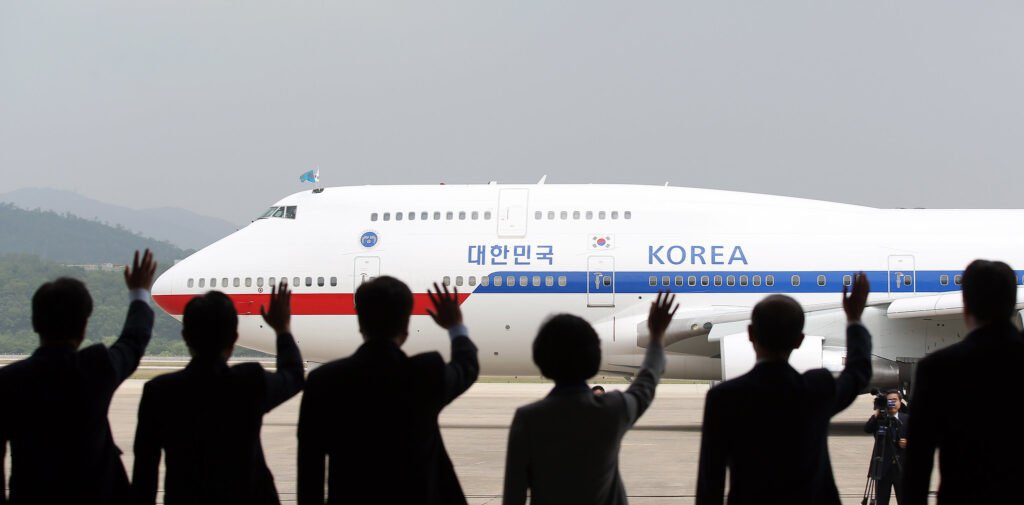The Peninsula
Security Agenda for Trump-Lee Summit May Renew Abandonment Concerns

The upcoming summit between U.S. President Donald Trump and newly elected South Korean President Lee Jae Myung is shaping up to be a crucial moment in the more than seventy-year-long alliance.
The two leaders inked a vague agreement on trade and investment late last month, which appears to have opened the door to good relations, and President Lee has eagerly sought this meeting to strengthen his legitimacy and demonstrate his diplomatic skills.
But the summit also has the potential to imperil the alliance. While some economic issues remain—not least the U.S. tariffs on automobiles and semiconductors—the meeting is more likely to focus on a range of contentious security issues, including U.S. demands for greater South Korean contributions to defense costs and pressures for South Korea to commit to join military contingencies in Taiwan and subordinate its policies to an aggressive U.S. stance toward China.
All of these issues are now joined under two broad policy umbrellas the Trump administration calls “alliance modernization” and “strategic flexibility.”
Both concepts embody the idea of shifting the alliance away from its sole focus on deterring North Korea toward a broader regional approach that prioritizes confrontation with China, including the use of U.S. Forces Korea (USFK) in a Taiwan contingency. China is the number one strategic threat to the United States, and allies and partners must “do more,” according to an interim strategic guidance document the U.S. Department of Defense issued in July.
“Strategic flexibility” means that in the event of a clash with China, U.S. military forces based in South Korea will be withdrawn and deployed elsewhere. It demands that South Korea take on the preponderant burden of defense against potential North Korean aggression.
USFK Commander Xavier Brunson recently stated that the “USFK must be able to move to other locations and perform other missions at any time” and that South Korea must “play a great role in responding to North Korea, and USFK demonstrate flexibility to perform other missions.”
General Brunson acknowledged South Korea’s desire to connect any moves in this direction with the completion of a plan to reform the current system of operational control (OPCON), which places South Korea’s military under U.S. command during wartime. OPCON transfer to South Korea has been a long-standing goal for South Korea, particularly under progressive administrations. If the United States shifts its focus, then “the transition of wartime operational control in which South Korea leads the defense of the Korean Peninsula, must also be expedited,” argued the progressive Kyunghyang Shinmun.
But Brunson pushed back against accelerating this process, telling reporters that “taking shortcuts to expedite the transfer of wartime operational control could jeopardize the readiness of the Korean Peninsula’s military.”
This has not stopped the Trump administration from preparing to push for South Korea’s acquiescence to their demands. An early draft of a U.S.-South Korea agreement sets a goal for the upcoming talks to compel South Korea to “issue a political statement supporting flexibility for USFK force posture to better deter China while continuing to deter [North Korea],” according to the Washington Post. This is to be paired with pressures to boost South Korea’s defense spending to 3.8 percent of GDP—up from 2.6 percent last year—and to vastly increase its support for the cost of basing U.S. forces.
Defense planners linked to Secretary of Defense Pete Hegseth have pushed more specific plans to drastically cut the number of U.S. troops based in South Korea from the current level of 28,500 to 10,000. This would be done by effectively removing all ground troops from South Korea, leaving only air units that can easily be deployed elsewhere.
The United States has maintained the right to deploy its forces anywhere, and reductions in troop levels are hardly unprecedented. But in return, the United States accepted the South Korean stance that “it shall not be involved in a regional conflict in Northeast Asia against the will of the Korean people.”
More profoundly, the United States’ plans undermine the basic pledge to defend South Korea in a war—a commitment that underlies the 1953 Mutual Defense Treaty between the two countries. The presence of U.S. ground forces is the famously labeled “tripwire” to guarantee the U.S. commitment.
“The continued presence of US troops at existing levels on the Korean Peninsula is more important than documents discussing ‘strategic flexibility’ or ‘modernized alliance,’” Senior Fellow at the Mansfield Foundation Bruce Klingner told this writer. “Maintaining U.S. troops in South Korea is a tangible manifestation of American commitment to the defense of its treaty partner. As such, they continue to be an integral part of Combined Forces Command and United Nations Command. In a conflict with North Korea, the American public and Congress would not allow a U.S. president to abandon them, particularly after casualties.”
The Trump administration faces resistance not only from South Korea but also from Congress, where support for the U.S. presence on the Korean Peninsula and opposition to downsizing the current troop levels remain strong, even among Republicans. The National Defense Authorization Act, which was passed by the Senate Armed Services Committee on July 9, prohibits a reduction in the U.S. military posture or a change in wartime OPCON until the secretary of defense certifies to Congress that “such action is in the national interest.” It also directs the Joint Chiefs of Staff, the Indo-Pacific Command, and USFK to carry out an independent assessment of any such changes.
The North Korea Connection
The push to refocus the U.S. regional presence away from North Korea and toward China could potentially be linked to another sensitive issue shaping the upcoming Trump-Lee summit—relations with North Korea.
Rumors and hints of a resumption of talks between Trump and North Korean leader Kim Jong Un have surfaced again in recent weeks. The Lee administration is supportive of such dialogue, as such moves are consistent with its desire to ease tensions with North Korea and revive serious engagement. But such talks are likely to only take place if Trump is heading seriously toward the withdrawal of U.S. forces from South Korea and acceptance of Kim’s demand that North Korea be recognized as a nuclear-weapon state.
“At some point, the ROK is going to pay a price for U.S.-DPRK dialogue if the U.S. under Trump decides to accept North Korea as a de facto nuclear state,” former senior Department of State official and Korea expert Evans Revere told KEI.
“The deeply progressive government in Seoul cannot possibly give the U.S. what it wants — agreement that the ROK will support the U.S. militarily in a China- or Taiwan-related contingency and agreement to allow the U.S. to use Korea-based forces against China,” argues Revere, who is now a nonresident senior fellow at the Brookings Institution. “And the U.S. does not wish to give the ROK what it wants — an open-ended commitment that Korea-based U.S. forces will be solely dedicated to the defense of the ROK against DPRK aggression.”
Summit Disasters of the Past
The possibility that the upcoming summit could lead to a serious clash is well understood in Seoul, based on past experience and the much-publicized Oval Office encounters between Trump and Ukrainian President Volodymyr Zelenskyy and other world leaders. In the case of South Korea, the 1993 meeting between presidents Bill Clinton and Kim Young-sam and the 2001 summit between presidents George W. Bush and Kim Dae-jung are representative examples of what could happen if things go wrong.
“In both cases, the meeting went badly because of North Korea,” recalls former U.S. Ambassador to South Korea Thomas Hubbard, who was a key participant in both summits. “In my mind they went badly because the Koreans failed to prepare carefully and understand where our president was.”
There are lessons for Lee Jae Myung, Hubbard told this writer in an interview. North Korea is not the problem now, as both Trump and Lee want to engage with North Korea. “The issue this time will be security relations, host nation support, and I don’t think anyone really knows where Trump is going to come down on troop levels in Korea. Lee Jae Myung is a progressive who wants to reach out to China but I think he is afraid Trump is going to make demands on troop reductions that will undercut him in Korea.”
Trump’s belief that there is no rationale to keep U.S. forces in South Korea is long-standing and unchanged. It is not hard to imagine a moment in the upcoming summit when Trump will once again raise this issue.
“I never took the strategic flexibility dispute seriously,” says Ambassador Hubbard, “but the danger is we push them too hard on Taiwan, on the relations with China, and at the same time raise questions about our strategic commitment.”
That could put the United States on a slippery slope toward abandoning its ally—something no South Korean leader would want to happen.
Daniel C. Sneider is a non-resident Distinguished Fellow at the Korea Economic Institute of America and a lecturer in East Asian Studies at Stanford University.
Photo from the Republic of Korea Flickr account.
KEI is registered under the FARA as an agent of the Korea Institute for International Economic Policy, a public corporation established by the government of the Republic of Korea. Additional information is available at the Department of Justice, Washington, D.C.
